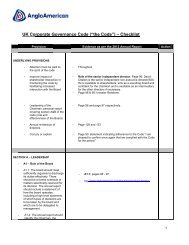OTHER INFORMATIONKEY FINANCIAL DATAUS$ million (unless otherwise stated) <strong>2012</strong> 2011 2010 2009 2008 2007 2006 (1) 2005 (1) 2004 (1)Group revenue including associates 32,785 36,548 32,929 24,637 32,964 30,559 29,404 24,872 22,610Less: Share of associates’ revenue (4,024) (5,968) (4,969) (3,779) (6,653) (5,089) (4,413) (4,740) (5,429)Group revenue 28,761 30,580 27,960 20,858 26,311 25,470 24,991 20,132 17,181Underlying operating profit including associates beforespecial items and remeasurements 6,164 11,095 9,763 4,957 10,085 9,590 8,888 5,549 3,832Special items and remeasurements (excluding financing and taxspecial items and remeasurements) (5,757) (44) 1,727 (208) (330) (227) 24 16 556Net finance costs (including financing special items andremeasurements), tax and non-controlling interests of associates (269) (452) (423) (313) (783) (434) (398) (315) (391)Total profit from operations and associates 138 10,599 11,067 4,436 8,972 8,929 8,514 5,250 3,997Net finance (costs)/income (including financing special itemsand remeasurements) (377) 183 (139) (407) (401) (108) (71) (220) (385)(Loss)/profit before tax (239) 10,782 10,928 4,029 8,571 8,821 8,443 5,030 3,612Income tax expense (including special items and remeasurements) (375) (2,860) (2,809) (1,117) (2,451) (2,693) (2,518) (1,208) (765)(Loss)/profit for the financial year – continuing operations (614) 7,922 8,119 2,912 6,120 6,128 5,925 3,822 2,847Profit for the financial year – discontinued operations – – – – – 2,044 997 111 1,094(Loss)/profit for the financial year – total Group (614) 7,922 8,119 2,912 6,120 8,172 6,922 3,933 3,941Non-controlling interests (879) (1,753) (1,575) (487) (905) (868) (736) (412) (440)(Loss)/profit attributable to equity shareholders ofthe Company (1,493) 6,169 6,544 2,425 5,215 7,304 6,186 3,521 3,501Underlying earnings (2) – continuing operations 2,839 6,120 4,976 2,569 5,237 5,477 5,019 3,335 2,178Underlying earnings (2) – discontinued operations – – – – – 284 452 401 506Underlying earnings (2) – total Group 2,839 6,120 4,976 2,569 5,237 5,761 5,471 3,736 2,684(Loss)/earnings per share (US$) – continuing operations (1.19) 5.10 5.43 2.02 4.34 4.04 3.51 2.35 1.84Earnings per share (US$) – discontinued operations – – – – – 1.54 0.70 0.08 0.60(Loss)/earnings per share (US$) – total Group (1.19) 5.10 5.43 2.02 4.34 5.58 4.21 2.43 2.44Underlying earnings per share (US$) – continuing operations 2.26 5.06 4.13 2.14 4.36 4.18 3.42 2.30 1.52Underlying earnings per share (US$) – discontinued operations – – – – – 0.22 0.31 0.28 0.35Underlying earnings per share (US$) – total Group 2.26 5.06 4.13 2.14 4.36 4.40 3.73 2.58 1.87Ordinary dividend per share (US cents) 85.0 74.0 65.0 – 44.0 124.0 108.0 90.0 70.0Special dividend per share (US cents) – – – – – – 67.0 33.0 –Weighted average basic number of shares outstanding (million) 1,254 1,210 1,206 1,202 1,202 1,309 1,468 1,447 1,434Underlying EBITDA (3) – continuing operations 8,686 13,348 11,983 6,930 11,847 11,171 10,431 7,172 5,359Underlying EBITDA (3) – discontinued operations – – – – – 961 1,766 1,787 1,672Underlying EBITDA (3) – total Group 8,686 13,348 11,983 6,930 11,847 12,132 12,197 8,959 7,031Underlying EBITDA interest cover (4) – total Group 61.2 n/a 42.0 27.4 28.3 42.0 45.5 20.0 18.5Operating margin (before special items and remeasurements) –total Group 18.8% 30.4% 29.6% 20.1% 30.6% 28.4% 25.4% 18.5% 14.7%Ordinary dividend cover (based on underlying earnings per share) –total Group 2.7 6.8 6.4 – 9.9 3.5 3.5 2.9 2.7Balance sheetIntangible assets and property, plant and equipment 49,660 42,871 42,126 37,974 32,551 25,090 25,632 33,368 35,816Other non-current assets and investments (5) 8,512 10,269 9,852 7,303 7,607 9,271 8,258 5,585 5,547Working capital 3,744 2,093 2,385 2,168 861 1,966 3,096 3,538 3,543Other net current liabilities (5) (990) (1,683) (785) (272) (840) (911) (1,430) (1,429) (611)Other non-current liabilities and obligations (5) (10,710) (9,220) (8,757) (8,487) (7,567) (6,387) (5,826) (8,491) (8,339)Cash and cash equivalents and borrowings (6) (8,660) (1,141) (7,038) (11,046) (11,051) (5,170) (3,244) (4,993) (8,243)Net assets classified as held for sale 2,231 – 188 429 195 471 641 – –Net assets 43,787 43,189 37,971 28,069 21,756 24,330 27,127 27,578 27,713Non-controlling interests (6,130) (4,097) (3,732) (1,948) (1,535) (1,869) (2,856) (3,957) (4,588)Equity attributable to equity shareholders of the Company 37,657 39,092 34,239 26,121 20,221 22,461 24,271 23,621 23,125Total capital (7) 52,402 44,563 45,355 39,349 33,096 29,181 30,258 32,558 35,806Cash flows from operations – continuing operations 7,021 11,498 9,924 4,904 9,579 9,375 9,012 5,963 3,857Cash flows from operations – discontinued operations – – – – – 470 1,045 1,302 1,434Cash flows from operations – total Group 7,021 11,498 9,924 4,904 9,579 9,845 10,057 7,265 5,291Dividends received from associates and financial assetinvestments – continuing operations 340 403 285 639 659 311 251 468 380Dividends received from associates and financial assetinvestments – discontinued operations – – – – – 52 37 2 16Dividends received from associates and financial assetinvestments – total Group 340 403 285 639 659 363 288 470 396Return on capital employed (8) – total Group 13.3% 26.5% 24.8% 14.4% 36.9% 38.0% 32.6% 18.8% 16.9%EBITDA/average total capital (7) – total Group 17.9% 29.7% 28.3% 19.1% 38.0% 40.8% 38.8% 26.2% 21.3%Net debt to total capital (gearing) (9) 16.4% 3.1% 16.3% 28.7% 34.3% 16.6% 10.3% 15.3% 22.6%(1)Comparatives for 2006, 2005 and 2004 were adjusted in the 2007 <strong>Annual</strong> <strong>Report</strong> to reclassify amounts relating to discontinued operations where applicable.(2)Underlying earnings is profit attributable to equity shareholders of the Company before special items and remeasurements and is therefore presented after net finance costs, income tax andnon-controlling interests.(3)Underlying EBITDA is operating profit before special items and remeasurements, depreciation and amortisation in subsidiaries and joint ventures and includes attributable share of EBITDAof associates.(4)Underlying EBITDA interest cover is underlying EBITDA divided by net finance costs, excluding other net financial income, exchange gains and losses on monetary assets and liabilities,unwinding of discount relating to provisions and other liabilities, financing special items and remeasurements, and including attributable share of associates’ net interest expense, which in 2011resulted in a net finance income and therefore the ratio is not applicable.(5)Comparatives for 2008, 2007, 2006 and 2005 were adjusted in the 2009 <strong>Annual</strong> <strong>Report</strong> in accordance with IAS 1 Presentation of Financial Statements – Improvements to reclassify non-hedgederivatives whose expected settlement date was more than one year from the period end from current to non-current.(6)This differs from the Group’s measure of net debt as it excludes the net cash/(debt) of disposal groups (<strong>2012</strong>: $213 million; 2011: nil; 2010: $59 million; 2009: $48 million; 2008: $8 million;2007: $(69) million; 2006: $(80) million; 2005: nil; 2004: nil) and excludes related hedges (<strong>2012</strong>: net liabilities of $168 million; 2011: net liabilities of $233 million; 2010: net liabilities of$405 million; 2009: net liabilities of $285 million; 2008: net liabilities of $297 million; 2007: net assets of $388 million; 2006: net assets of $193 million; 2005: nil; 2004: nil). See note 31 to thefinancial statements.(7)Total capital is net assets excluding net debt.(8)Return on capital employed is calculated as total operating profit before impairments for the year divided by the average of total capital less other investments and adjusted for impairments.(9)Net debt to total capital is calculated as net debt (including related hedges) divided by total capital. Comparatives are presented on a consistent basis.238 <strong>Anglo</strong> <strong>American</strong> plc <strong>Annual</strong> <strong>Report</strong> <strong>2012</strong>
OTHER INFORMATIONNON-FINANCIAL DATA<strong>2012</strong> 2011 2010 2009 2008Safety (1)Work-related fatalities 13 17 15 20 28Fatal-injury frequency rate (FIFR) (2) 0.008 0.009 0.008 0.010 0.015Total recordable case frequency rate (TRCFR) (3) 1.29 2.01 1.44 1.81 2.27Lost time injury frequency rate (LTIFR) (4) 0.60 0.64 0.64 0.76 1.04Lost time injury severity rate (LTISR) (5) 223 220 229 226 240Occupational health (1)New cases of occupational disease (NCOD) (6) 170 197 268 489 132Occupational disease incidence rate (per 200,000 hours) (ODIR) 0.189 0.205 0.284 0.483 0.126Environment (1)Total CO 2emissions (Mt CO 2e) 18 19 20 19 19Total energy consumed (million GJ) (7) 108 102 100 106 102Water used for primary activities (million m 3 ) (8) 122 115 115 125 124Human Resources (1)(9)Women in management (%) (10) 23 22 21 19 17Historically Disadvantaged South Africans in management (%) (11) 62 51 46 46 45Resignations (%) (12) 2.4 2.7 2.4 2.4 3.8Redundancies (%) (13) 0.6 1.4 2.1 3.8 0.6Dismissals (%) (14) 1.4 1.1 1.3 2.0 2.6Other reasons for leaving (%) (15) 2.4 0.3 2.8 4.9 2.0Social (1)CSI spend (total in US$ million) (16) 154 129 112 83 76CSI spend (% of pre-tax profit) 3 1 1 2 1Procurement: BEE spend (rand billion) 25.8 23.3 20.9 23.5 24.6Businesses supported through enterprise development initiatives 17,598 38,681 9,392 3,720 3,012Jobs created/maintained through enterprise development programmes 64,927 47,070 17,200 12,982 13,431(1)With the exception of Social, which includes the results of De Beers from the date of acquisition, the data includes wholly owned subsidiaries and joint ventures over which <strong>Anglo</strong> <strong>American</strong> hasmanagement control, and does not include De Beers or other non-managed operations such as Collahuasi, Carbones del Cerrejón and Samancor.(2)FIFR is calculated as the number of fatal injuries to employees or contractors per 200,000 hours worked.(3)TRCFR is the number of fatal injuries, lost time injuries and medical treatment cases for employees or contractors per 200,000 hours.(4)LTIFR is the number of lost time injuries (LTIs) per 200,000 hours worked. An LTI is an occupational injury which renders the person unable to perform his/her regular duties for one full shift ormore, the day after the injury was incurred, whether a scheduled workday or not.(5)LTISR is the number of lost days and restricted workdays per 200,000 hours worked.(6)NCOD is the sum of occupational diseases due to asbestosis, NIHL, silicosis, coal-workers’ pneumoconiosis, pneumoconiosis due to other fibrogenic diseases, chronic obstructive airwaysdisease, occupational tuberculosis, occupational asthma, HAVs, musculoskeletal disorders, dermatitis, occupational cancers and other occupational diseases.(7)Total amount of energy consumed is the sum of total energy from electricity purchased, total energy from fossil fuels and total energy from renewable fuels.(8)Total amount of water used for primary activities is the total new or make-up water entering the operation and used for the operation’s primary operational activities.(9)Excludes Other Mining and Industrial Non-core operations.(10)Women in management is the percentage of female managers as a percentage of all females in the workforce excluding contractors.(11)Historically Disadvantaged South Africans in management is the percentage of managers at <strong>Anglo</strong> <strong>American</strong> in South Africa who are ‘Historically Disadvantaged South Africans’.(12)The number of people who resigned as a percentage of the total workforce excluding contractors.(13)The number of people who have been retrenched as a percentage of total workforce excluding contractors.(14)The number of people who have been dismissed or have resigned to avoid dismissal, as a percentage of total workforce excluding contractors.(15)The number of people who left for reasons other than those shown above, for example retirement, ill health and death, as a percentage of total workforce excluding contractors.(16)CSI spend is the sum of donations for charitable purposes and community investment (which includes cash and in-kind donations and staff time) as well as investments in commercial initiativeswith public benefit (such as enterprise development).Other information<strong>Anglo</strong> <strong>American</strong> plc <strong>Annual</strong> <strong>Report</strong> <strong>2012</strong> 239
- Page 1 and 2:
A BALANCEDPORTFOLIOWITH THE FUTURE
- Page 4 and 5:
HeadquartersLondon,United KingdomCo
- Page 6 and 7:
OVERVIEW CHAIRMAN’S STATEMENTCHAI
- Page 8 and 9:
OVERVIEW MARKETPLACEA BRIGHTER OUTL
- Page 10 and 11:
OVERVIEW MARKETPLACEWELL PLACED FOR
- Page 12 and 13:
OVERVIEW OUR STRATEGY AND BUSINESS
- Page 14 and 15:
OVERVIEW CHIEF EXECUTIVE’S STATEM
- Page 16 and 17:
OPERATING AND FINANCIAL REVIEW KEY
- Page 18 and 19:
OPERATING AND FINANCIAL REVIEW STRA
- Page 20 and 21:
OPERATING AND FINANCIAL REVIEW STRA
- Page 22 and 23:
OPERATING AND FINANCIAL REVIEW STRA
- Page 24 and 25:
OPERATING AND FINANCIAL REVIEW STRA
- Page 26 and 27:
OPERATING AND FINANCIAL REVIEW STRA
- Page 28 and 29:
OPERATING AND FINANCIAL REVIEW STRA
- Page 30 and 31:
OPERATING AND FINANCIAL REVIEW STRA
- Page 32 and 33:
OPERATING AND FINANCIAL REVIEW STRA
- Page 34 and 35:
OPERATING AND FINANCIAL REVIEW STRA
- Page 36 and 37:
OPERATING AND FINANCIAL REVIEW STRA
- Page 38 and 39:
OPERATING AND FINANCIAL REVIEW STRA
- Page 40 and 41:
OPERATING AND FINANCIAL REVIEW RESO
- Page 42 and 43:
OPERATING AND FINANCIAL REVIEW RESO
- Page 44 and 45:
OPERATING AND FINANCIAL REVIEW RESO
- Page 46 and 47:
OPERATING AND FINANCIAL REVIEW GROU
- Page 48 and 49:
OPERATING AND FINANCIAL REVIEW GROU
- Page 50 and 51:
OPERATING AND FINANCIAL REVIEW GROU
- Page 52 and 53:
OPERATING AND FINANCIAL REVIEW RISK
- Page 54 and 55:
OPERATING AND FINANCIAL REVIEW RISK
- Page 56 and 57:
OPERATING AND FINANCIAL REVIEW RISK
- Page 58 and 59:
OPERATING AND FINANCIAL REVIEW IRON
- Page 60 and 61:
OPERATING AND FINANCIAL REVIEW IRON
- Page 62 and 63:
OPERATING AND FINANCIAL REVIEW IRON
- Page 64 and 65:
OPERATING AND FINANCIAL REVIEW META
- Page 66 and 67:
OPERATING AND FINANCIAL REVIEW META
- Page 68 and 69:
OPERATING AND FINANCIAL REVIEW THER
- Page 70 and 71:
OPERATING AND FINANCIAL REVIEW THER
- Page 72 and 73:
OPERATING AND FINANCIAL REVIEW COPP
- Page 74 and 75:
OPERATING AND FINANCIAL REVIEW COPP
- Page 76 and 77:
OPERATING AND FINANCIAL REVIEW NICK
- Page 78 and 79:
OPERATING AND FINANCIAL REVIEW NICK
- Page 80 and 81:
OPERATING AND FINANCIAL REVIEW PLAT
- Page 82 and 83:
OPERATING AND FINANCIAL REVIEW PLAT
- Page 84 and 85:
OPERATING AND FINANCIAL REVIEW PLAT
- Page 86 and 87:
OPERATING AND FINANCIAL REVIEW DIAM
- Page 88 and 89:
OPERATING AND FINANCIAL REVIEW DIAM
- Page 90 and 91:
OPERATING AND FINANCIAL REVIEW OTHE
- Page 92 and 93:
OPERATING AND FINANCIAL REVIEW OTHE
- Page 94 and 95:
GOVERNANCE INTRODUCTIONGOVERNANCESi
- Page 96 and 97:
GOVERNANCE THE BOARDTHE BOARDCHAIRM
- Page 98 and 99:
GOVERNANCE EXECUTIVE MANAGEMENTEXEC
- Page 100 and 101:
GOVERNANCE ROLE OF THE BOARDTHE ROL
- Page 102 and 103:
GOVERNANCE BOARD IN ACTIONBOARD VIS
- Page 104 and 105:
GOVERNANCE BOARD IN ACTIONBOARDCOMM
- Page 106 and 107:
GOVERNANCE BOARD IN ACTIONNOMINATIO
- Page 108 and 109:
GOVERNANCE AUDIT COMMITTEE REPORTAU
- Page 110 and 111:
GOVERNANCE AUDIT COMMITTEE REPORTOb
- Page 112 and 113:
GOVERNANCE DIRECTORS’ REMUNERATIO
- Page 114 and 115:
GOVERNANCE DIRECTORS’ REMUNERATIO
- Page 116 and 117:
GOVERNANCE DIRECTORS’ REMUNERATIO
- Page 118 and 119:
GOVERNANCE DIRECTORS’ REMUNERATIO
- Page 120 and 121:
GOVERNANCE DIRECTORS’ REMUNERATIO
- Page 122 and 123:
GOVERNANCE DIRECTORS’ REMUNERATIO
- Page 124 and 125:
GOVERNANCE DIRECTORS’ REMUNERATIO
- Page 126 and 127:
GOVERNANCE DIRECTORS’ REMUNERATIO
- Page 128 and 129:
GOVERNANCE DIRECTORS’ REMUNERATIO
- Page 130 and 131:
GOVERNANCE DIRECTORS’ REMUNERATIO
- Page 132 and 133:
GOVERNANCE DIRECTORS’ REPORTDIREC
- Page 134 and 135:
GOVERNANCE DIRECTORS’ REPORTEMPLO
- Page 136 and 137:
GOVERNANCE DIRECTORS’ REPORTIssue
- Page 138 and 139:
GOVERNANCE STATEMENT OF DIRECTORS
- Page 140 and 141:
FINANCIAL STATEMENTSRESPONSIBILITY
- Page 142 and 143:
FINANCIAL STATEMENTS PRINCIPAL STAT
- Page 144 and 145:
FINANCIAL STATEMENTS PRINCIPAL STAT
- Page 146 and 147:
FINANCIAL STATEMENTSNOTES TO THE FI
- Page 148 and 149:
FINANCIAL STATEMENTS NOTES TO THE F
- Page 150 and 151:
FINANCIAL STATEMENTS NOTES TO THE F
- Page 152 and 153:
FINANCIAL STATEMENTS NOTES TO THE F
- Page 154 and 155:
FINANCIAL STATEMENTS NOTES TO THE F
- Page 156 and 157:
FINANCIAL STATEMENTS NOTES TO THE F
- Page 158 and 159:
FINANCIAL STATEMENTS NOTES TO THE F
- Page 160 and 161:
FINANCIAL STATEMENTS NOTES TO THE F
- Page 162 and 163:
FINANCIAL STATEMENTS NOTES TO THE F
- Page 164 and 165:
FINANCIAL STATEMENTS NOTES TO THE F
- Page 166 and 167:
FINANCIAL STATEMENTS NOTES TO THE F
- Page 168 and 169:
FINANCIAL STATEMENTS NOTES TO THE F
- Page 170 and 171:
FINANCIAL STATEMENTS NOTES TO THE F
- Page 172 and 173:
FINANCIAL STATEMENTS NOTES TO THE F
- Page 174 and 175:
FINANCIAL STATEMENTS NOTES TO THE F
- Page 176 and 177:
FINANCIAL STATEMENTS NOTES TO THE F
- Page 178 and 179:
FINANCIAL STATEMENTS NOTES TO THE F
- Page 180 and 181:
FINANCIAL STATEMENTS NOTES TO THE F
- Page 182 and 183:
FINANCIAL STATEMENTS NOTES TO THE F
- Page 184 and 185:
FINANCIAL STATEMENTS NOTES TO THE F
- Page 186 and 187:
FINANCIAL STATEMENTS NOTES TO THE F
- Page 188 and 189:
FINANCIAL STATEMENTS NOTES TO THE F
- Page 190 and 191:
FINANCIAL STATEMENTS NOTES TO THE F
- Page 192 and 193: FINANCIAL STATEMENTS NOTES TO THE F
- Page 194 and 195: FINANCIAL STATEMENTS NOTES TO THE F
- Page 196 and 197: ORE RESERVES AND MINERAL RESOURCESE
- Page 198 and 199: ORE RESERVES AND MINERAL RESOURCESE
- Page 200 and 201: ORE RESERVES AND MINERAL RESOURCESI
- Page 202 and 203: ORE RESERVES AND MINERAL RESOURCESI
- Page 204 and 205: ORE RESERVES AND MINERAL RESOURCESC
- Page 206 and 207: ORE RESERVES AND MINERAL RESOURCESC
- Page 208 and 209: ORE RESERVES AND MINERAL RESOURCESC
- Page 210 and 211: ORE RESERVES AND MINERAL RESOURCESC
- Page 212 and 213: ORE RESERVES AND MINERAL RESOURCESC
- Page 214 and 215: ORE RESERVES AND MINERAL RESOURCESC
- Page 216 and 217: ORE RESERVES AND MINERAL RESOURCESC
- Page 218 and 219: ORE RESERVES AND MINERAL RESOURCESP
- Page 220 and 221: ORE RESERVES AND MINERAL RESOURCESP
- Page 222 and 223: ORE RESERVES AND MINERAL RESOURCESD
- Page 224 and 225: ORE RESERVES AND MINERAL RESOURCESD
- Page 226 and 227: ORE RESERVES AND MINERAL RESOURCESP
- Page 228 and 229: ORE RESERVES AND MINERAL RESOURCESR
- Page 230 and 231: ORE RESERVES AND MINERAL RESOURCESR
- Page 232 and 233: ORE RESERVES AND MINERAL RESOURCESD
- Page 234 and 235: ORE RESERVES AND MINERAL RESOURCESG
- Page 236 and 237: OTHER INFORMATION PRODUCTION STATIS
- Page 238 and 239: OTHER INFORMATION PRODUCTION STATIS
- Page 240 and 241: OTHER INFORMATIONEXCHANGE RATES AND
- Page 244 and 245: OTHER INFORMATIONRECONCILIATION OF
- Page 246 and 247: OTHER INFORMATIONTHE BUSINESS - AN
- Page 248 and 249: OTHER INFORMATIONSHAREHOLDER INFORM
- Page 250: Anglo American plc20 Carlton House



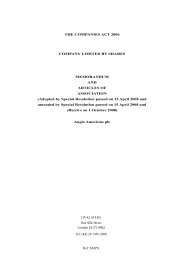
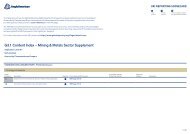
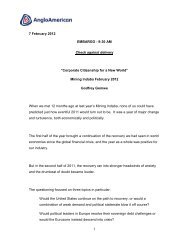
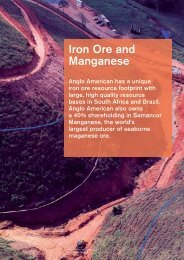
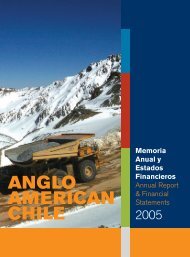
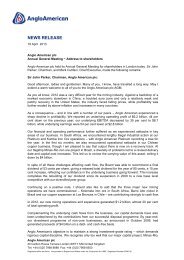
![English PDF [ 189KB ] - Anglo American](https://img.yumpu.com/50470814/1/184x260/english-pdf-189kb-anglo-american.jpg?quality=85)
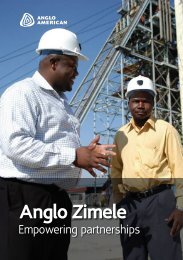

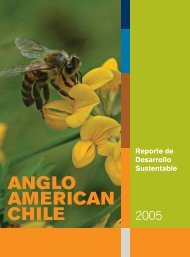
![pdf [ 595KB ] - Anglo American](https://img.yumpu.com/49420483/1/184x260/pdf-595kb-anglo-american.jpg?quality=85)
![pdf [ 1.1MB ] - Anglo American](https://img.yumpu.com/49057963/1/190x240/pdf-11mb-anglo-american.jpg?quality=85)
